The Dark Side of ZIP Codes
By Jon Engelsman
January 23, 2020
A look into the history of ZIP Codes and, echoing skepticism of the 1960's, a question about their relevance in today's society.
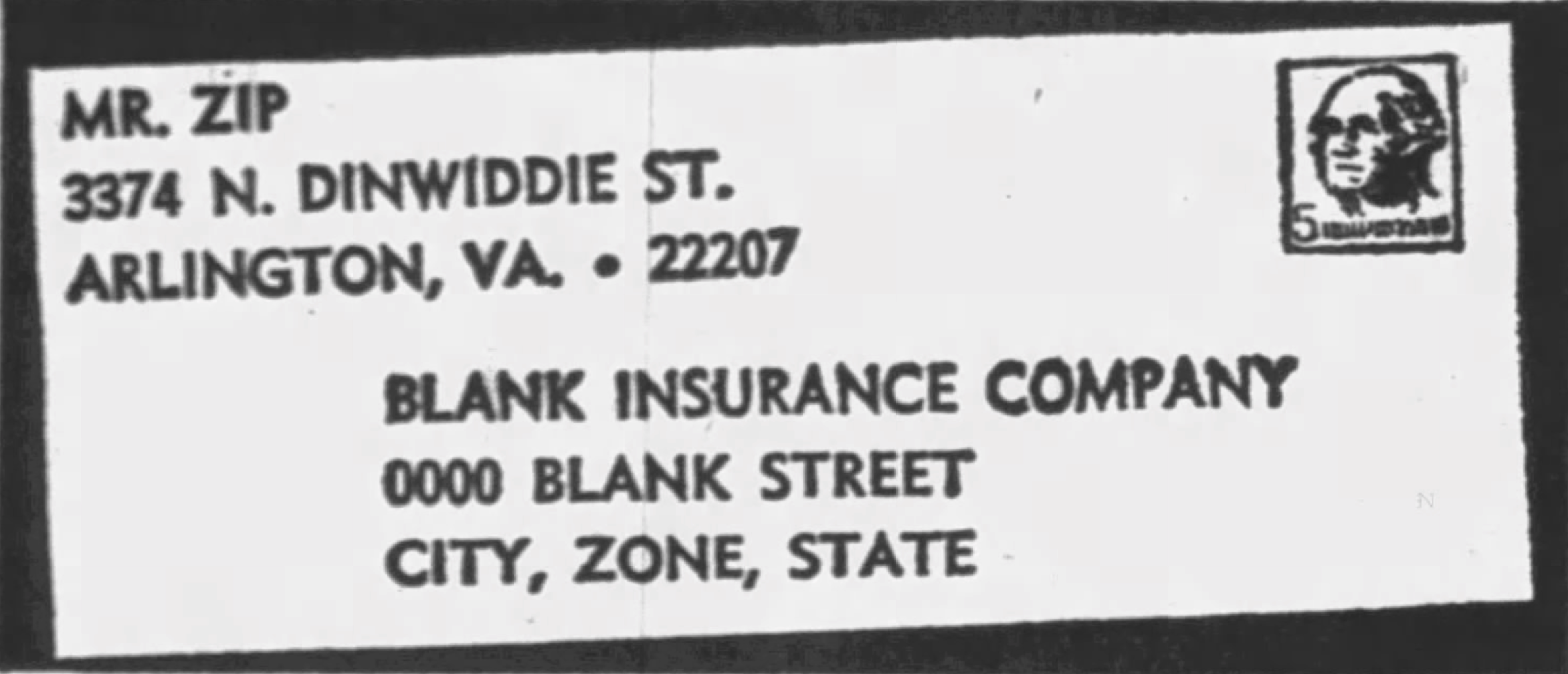
What’s In An Address?
Addresses are funny things when you start to think about them too much. Think about your own address in your head. You hopefully know where your house number is (that’s where you live), and you can probably picture the length of your street easily enough. I’ll assume you can picture the rough outline of the state that you live in as well as the general boundary of your city or town, within a reasonable approximation. But do you have any idea what the size or shape of your ZIP code looks like? And do you know the extent to which your ZIP code defines you?
ZIP Codes
Zone Improvement Plan, or ZIP, codes were first introduced by the US Postal Service in 1963. The 5-digit codes were aimed at improving the efficiency and accuracy of how mail was processed and sorted, breaking up the country into different geographic zones with a manageable set of numbers.
The ZIP code was an extension of 2-digit “postal codes” that were introduced in 1943 to a limited number of major cities, specifically intended to help inexperienced postal workers during a skilled labor shortage caused by World War II. A year later, a Postal Inspector in Philadelphia, Robert Moon, suggested a 3-digit code scheme that would expand this concept. But it would take some twenty years for Postmaster General Edward Day, faced with a rising sea of business mail that was inundating post offices around the country in the 1960’s, to recognize the potential value of these coding schemes, combining the older 2-digit and 3-digit ideas in a newly devised plan by postal inspector H. Bentley Hahn that would become the 5-digit ZIP code.
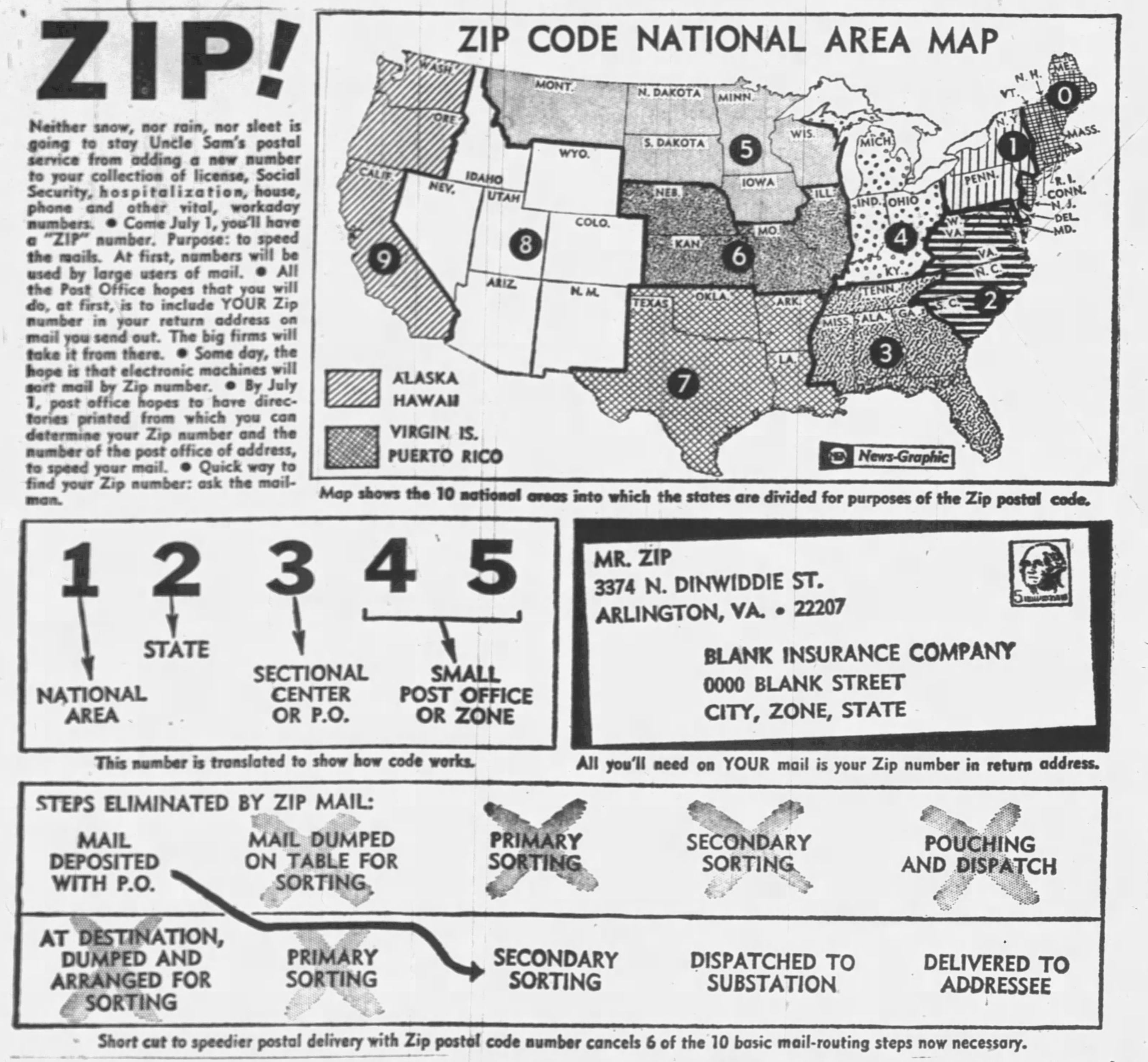 The Daily Herald (Provo, Utah), July 7th 1963
The Daily Herald (Provo, Utah), July 7th 1963
Each number in the 5-digit code represents an increasingly precise geographic region in the US. The first digit defines one of 10 different “national areas” in the United States. The second digit indicates a state, or part of a state, in that area. The third digit identifies a sectional center facility (SCF), a mail processing and distribution facility operated by the US Postal Service. It’s the last two digits then (and the ZIP code as a whole) that identifies either a specific post office, a small geographic region of addresses without a post office or even large buildings that receive a lot of mail.
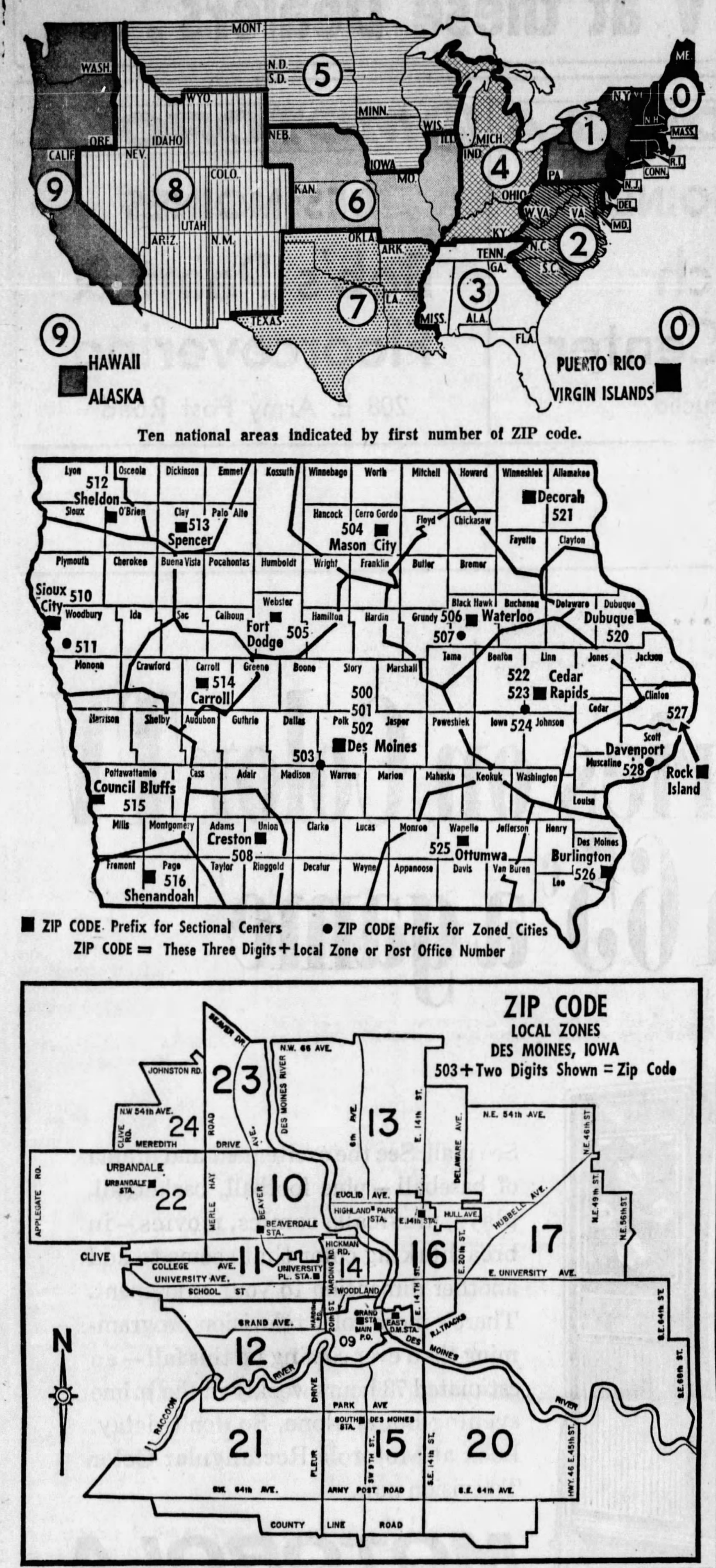 The Des Moines Register, October 2nd 1966
The Des Moines Register, October 2nd 1966
A 5-digit ZIP code comprised of the numbers 0-9 only has 100,000 possible codes available, ranging from 00000 to 99999. That limit on the number of available codes has never been a problem so far since the number of post offices in the US peaked in 1901 with 76,945. By the time ZIP codes were introduced in 1963, that number was down to 34,498. But the Postal Service has never come close to allocating all 100,000 codes, and only about 40,000 ZIP codes are ever actively allocated at any give time, although the Postal Service periodically adds or deletes ZIP codes as needed.
For even more precise categorization of locations and sorted mail, the US Postal Service rolled out a nine-digit ZIP+4 after a prolonged push-back from Congress back in 1983, twenty years after the original ZIP codes were introduced. These extra four digits divvy up a ZIP code region into blocks and segments, where blocks usually denote a specific side of a street or even a large building and a segment indicates a smaller portion of that block, possibly even a specific floor of a building.
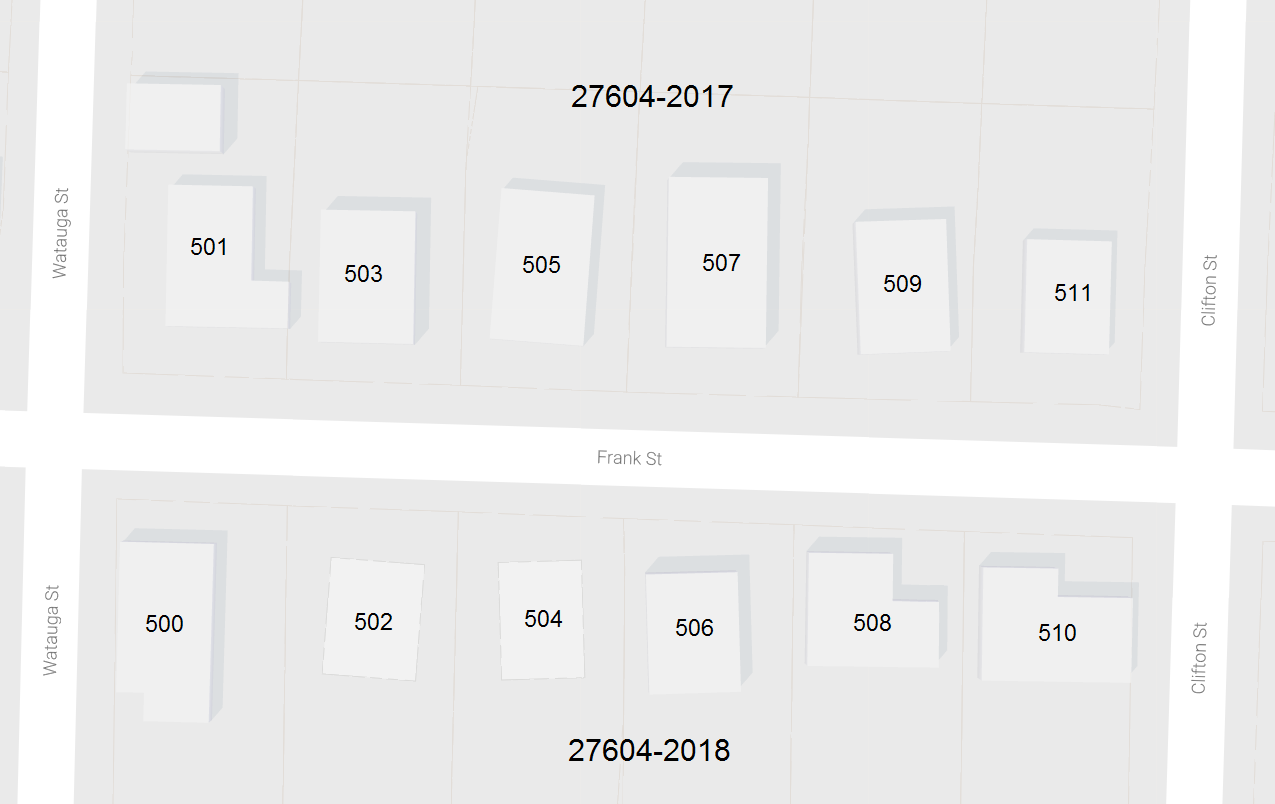 ZIP+4 and DPC explained, Gary Sanders, Logics Solutions
ZIP+4 and DPC explained, Gary Sanders, Logics Solutions
When a ZIP+4 is combined with another 2-digit number called the DPC or Delivery Point Code (usually just the last two digits of a house number), the resulting 11-digit number is a unique identifier for any given deliverable address in the United States.
Most of us never see these 11-digit ZIP codes since DPC’s are usually only used behind the scenes at the US Postal Service. Every once in a while however, a motivated online form might try and correct our address and ZIP code, asking us to verify the ZIP+4 code. But by and large, all we ever remember and use on a regular basis is the standard 5-digit ZIP code.
A Skeptical Reception
But even five digits was seen as five digits too many by a general public that was increasingly annoyed by all of the numbers in their lives back in 1963. It had been less than 30 years since people had received their first Social Security Numbers and only 15 some years since 10-digit phone numbers and direct dialing had been introduced by AT&T. People increasingly felt that mechanization and automation was slowly turning society into a life run by numbers.
And seeing as the post office was where people had gone to receive their new Society Security Numbers and was responsible for delivering those thick yellow books with pages full of 10-digit phone numbers, you can only imagine the inherent skepticism that people must have felt towards the US Postal Service when it came to numbers. A number of local newspaper articles at the time reflected such frustrations.
Some openly and unashamedly make sport of the idea, while the introduction of the 'zip code' has renewed the old squawks (and there were plenty) about mankind, at least in America, being absolutely surrounded and enveloped in a maze of numbers for this purpose or that, but all being the work of the government in the assignment and distribution of them.
The Democrat-Argus, August 30th 1963
Neither snow, nor rain, nor sleet is going to stay Uncle Sam's postal service from adding a new number to your collection of license, Social Security, hospitalization, house, phone and other vial, workaday numbers.
The Daily Herald (Provo, Utah), July 7th 1963
In America, a nation of efficiency and organization, codes exist for everything from social security to long-distance telephone dialing. The post office department's newly installed Zip Code may have been the last straw for citizens of a sometimes over-organized society.
The Daily Herald (Chicago, Illinois), August 22nd 1963
There are just too many numbers to remember. People are rebelling with apathy.
The Daily Herald (Chicago, Illinois), August 22nd 1963
Even twenty years later, the public would express similar reservations when the Postal Serviced introduced those ZIP+4 codes in the 1980’s. In an opinion piece titled “Zip plus 4 equals nonsense, not nine”, one writer made a bold technology prediction about the difficulties that even modern electronics would have with remembering so many digits:
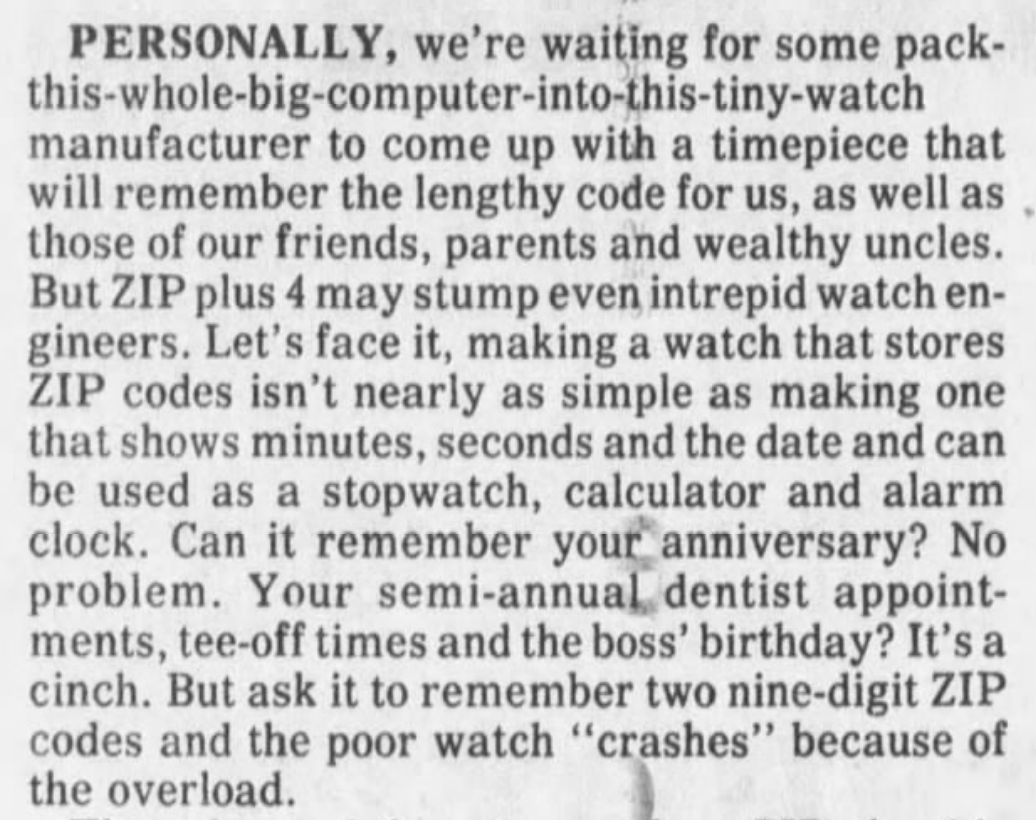 Palladium-Item (Richmond, IN), September 1st 1981
Palladium-Item (Richmond, IN), September 1st 1981
Even back in 1963, the US Postal Service knew that even just a simple 5-digit ZIP code was going to be a tough sell to the public. But they also knew they had to do something to stem the tide of inefficient mail sorting, and ZIP codes were the answer. Luckily, the Postal Service is nothing if not known for their marketing and branding savvy, so they had something up their sleeve that would convince the American public that they really ought to use these new ZIP codes.
Mr ZIP
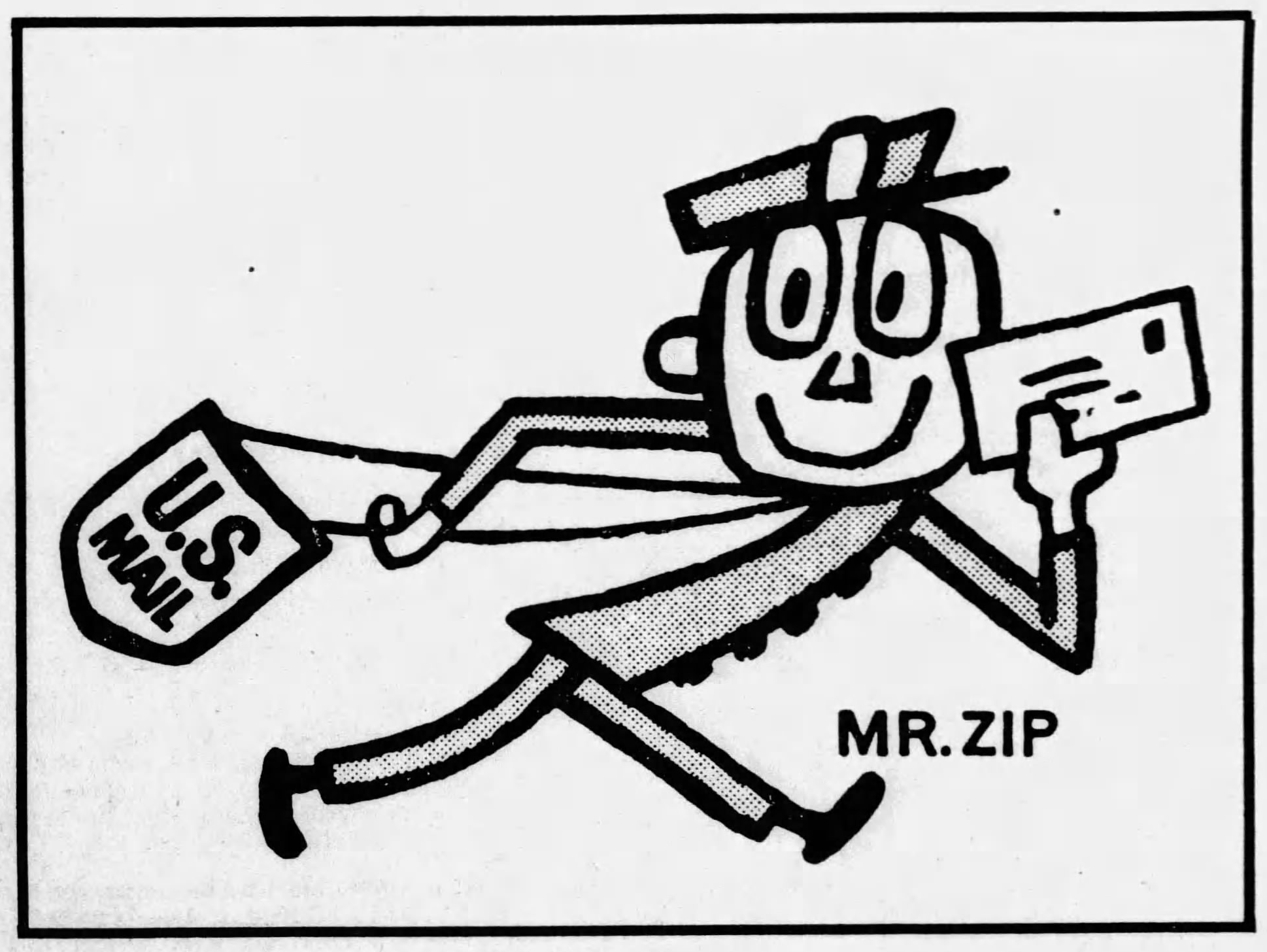
Meet Mr. ZIP. A quick, happy and efficient postal worker yet also a relatable man-about-town who always uses ZIP codes. A model citizen.
Introduced by the US Postal Service in 1963, Mr. ZIP was the face of the ZIP code campaign. His busy demeanor was everywhere at the time, blanketing post offices across the country with life-sized posters, buttons and all manners of propaganda paraphernalia (a surplus boon to modern postal memorabilia collectors). But post offices at the time were only given a short two months heads-up to begin gearing up for the “saturation campaign”, as an official Postal Service memorandum from July 1963 so clearly demanded.
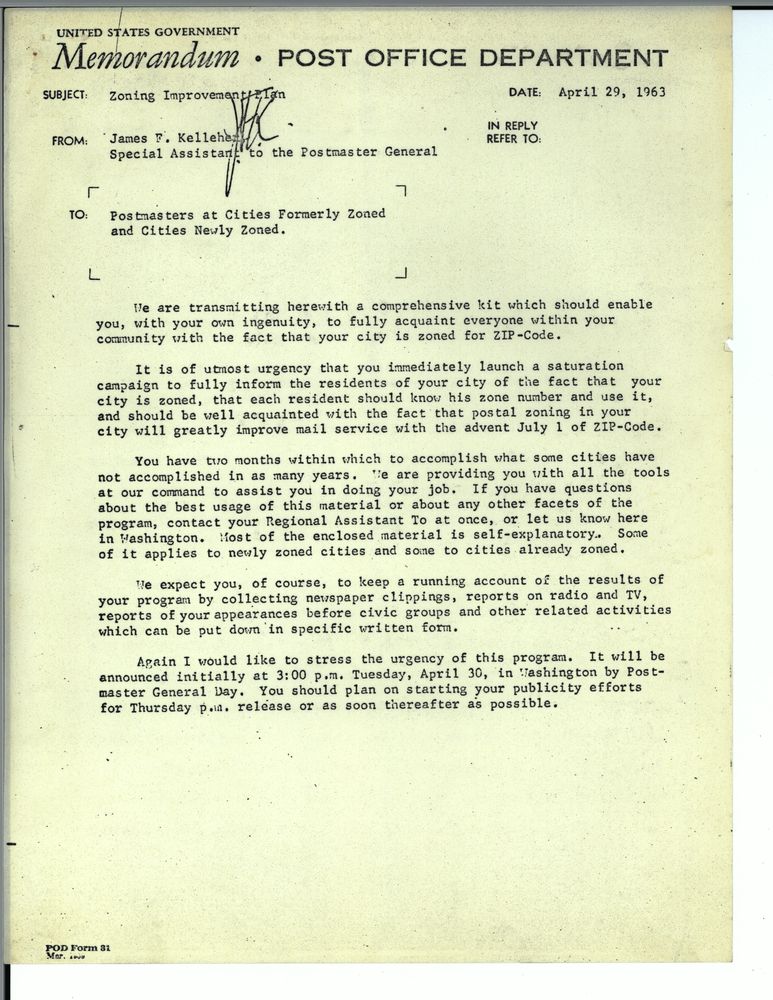 John F Kennedy Presidential Library, H. Bentley Hahn Personal Papers
John F Kennedy Presidential Library, H. Bentley Hahn Personal Papers
Well suited to the role of front man in the Postal Service’s ZIP code awareness campaign, a postal spokesman noted how Mr. ZIP was putting a spring in the step of one local post office.
"Things have changed around here", said the spokesman."For years, to give an example, the post office directory has been staid and plain, just like the department. But look here, at the new directory." He holds a volume the size of a telephone book. On the cover, grinning happily, is Mr Zip.
The Kansas City Times, July 10th 1963
But Mr. ZIP was more than just a smiling face. He had an important message to tell the people, but first he needed them to understand how ZIP codes worked.
Source: National Postal Museum
Then he had to explain why they were so important to the efficient workings of the US Postal Service. With step-by-step instructions, Mr. ZIP educated the entire country on how they too could start using ZIP codes.
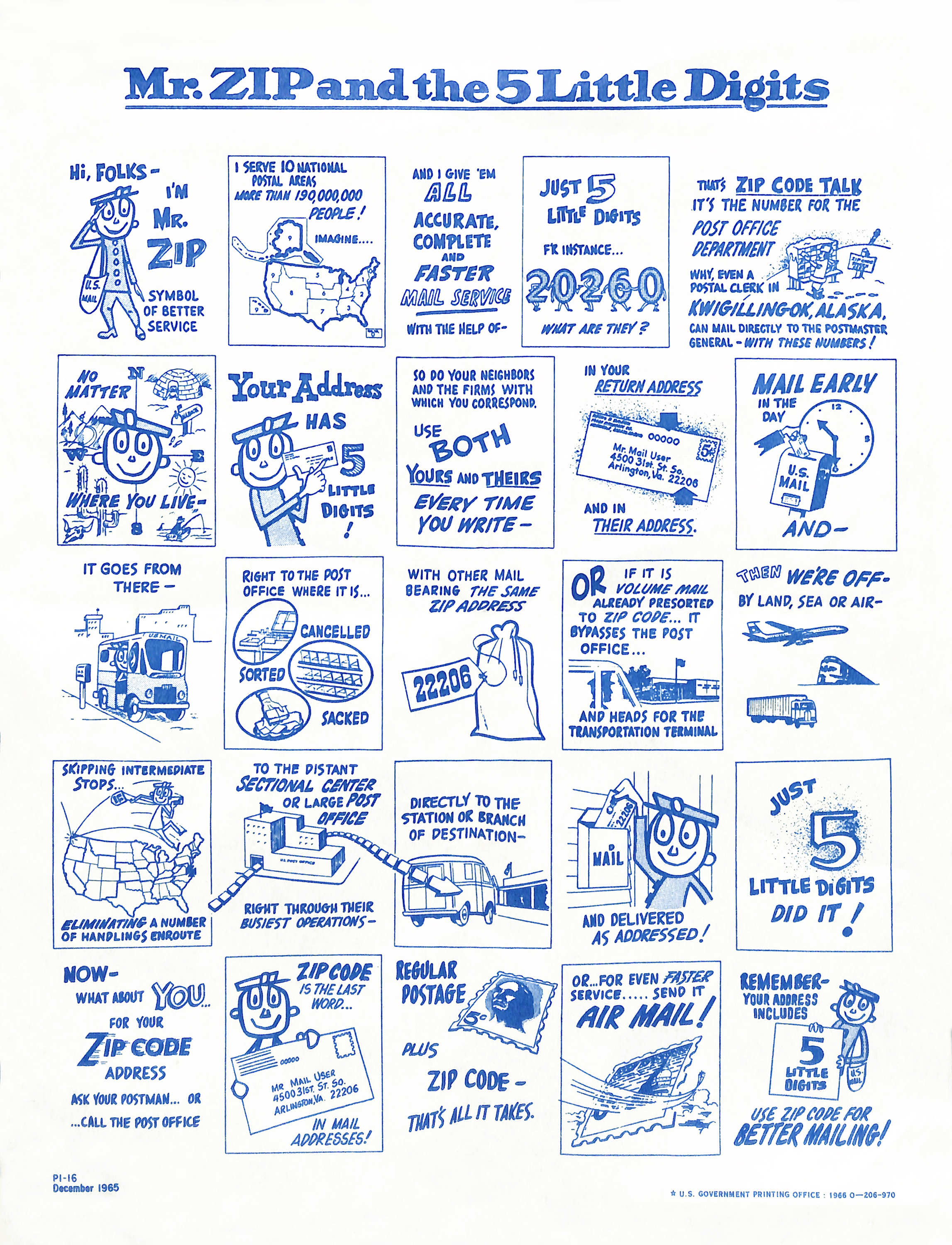 National Postal Museum
National Postal Museum
No one could escape the pervasive Postal Service’s messaging, whose campaign even enlisted Ethel Merman for a sing-song reminder, to the tune of that 1946 hit “Zip-a-Dee-Doo-Dah” (see what they did there?) to encourage the use of ZIP codes.
Source: National Postal Museum
While some parts of the ZIP code publicity campaign were light-hearted in nature, there were some elements of what I’ll call “ZIP shaming” that were involved too. Some endeavouring post offices enlisted young women from local colleges, bestowing them with the honorary title of “Miss ZIP”, to interrogate people on the street to see if they were memorizing their ZIP codes.
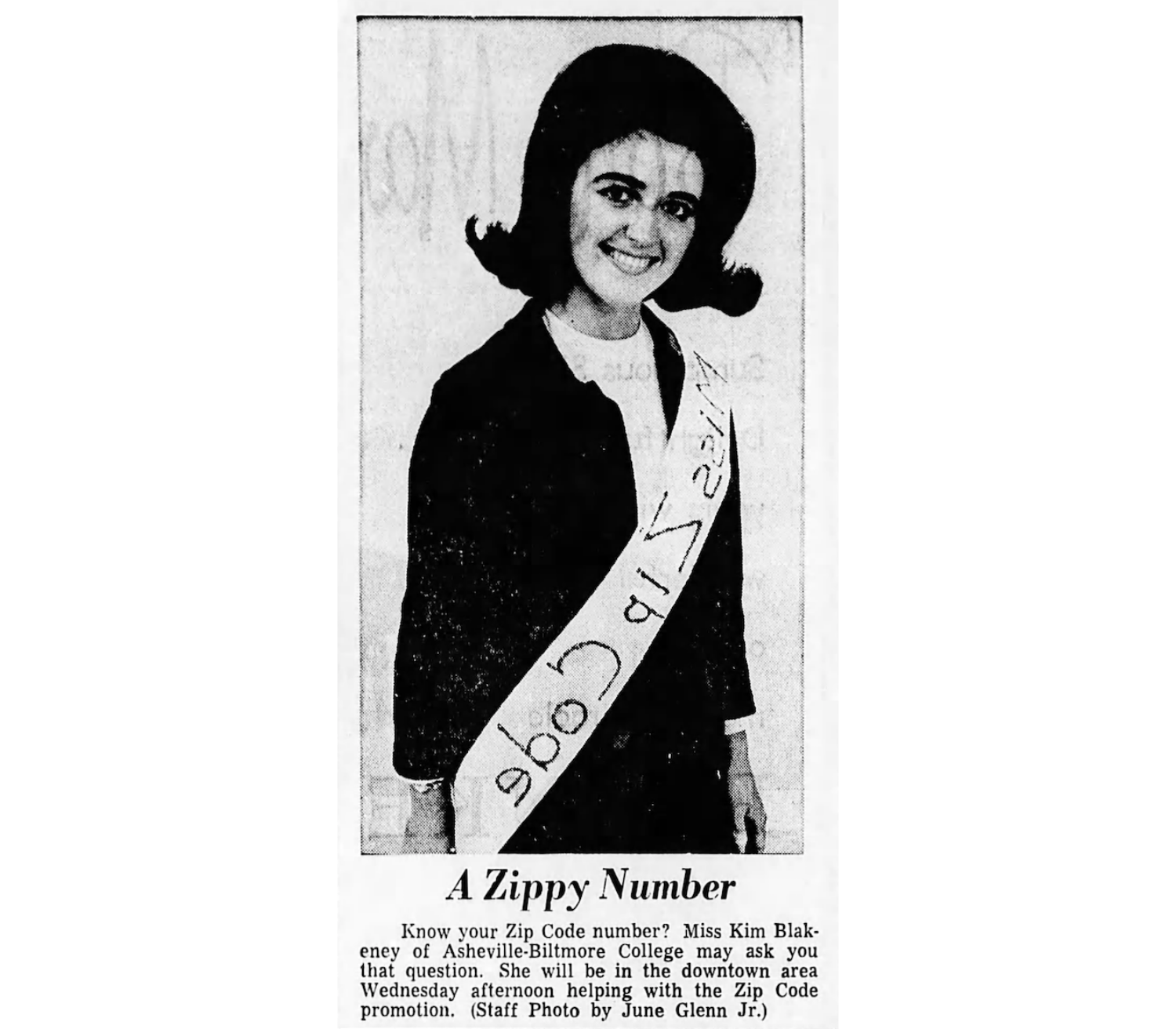 Asheville-Citizen Times, October 9th 1966
Asheville-Citizen Times, October 9th 1966
The Postal Service even went so far as to suggest that if you didn’t bother to use ZIP codes, you might as well be tearing all of your stamps in half, those most vital and precious of economic resources.
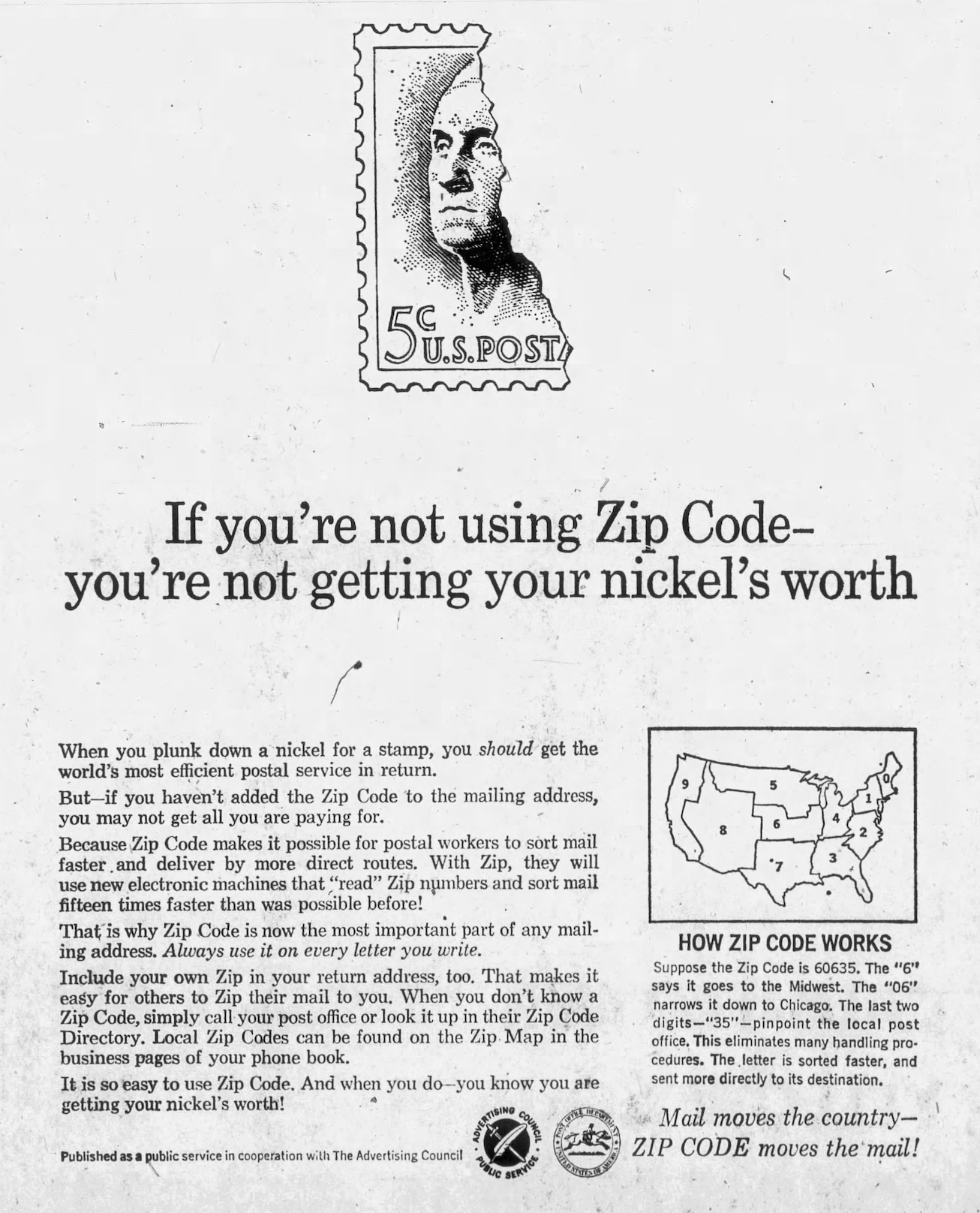 The Berkshire Eagle (Pittsfield, Pennsylvania), May 22nd 1967
The Berkshire Eagle (Pittsfield, Pennsylvania), May 22nd 1967
The general public surely felt a strong sense of anxiety (as the Postal Service intended), wondering if they were doing their part to contribute to the ZIP code effort in defeating postal inefficiency, an anxiety reflected in a classic Peanuts cartoon of the time.
 Peanuts, September 27th 1963
Peanuts, September 27th 1963
But the Postal Service’s ZIP code messaging campaign wasn’t limited to just the adult mail-sending population.
Since January of this year, approximately 600 second grade students of Provo and neighboring communities, have toured the Provo Post Office. One of the most important things we try to teach them is the importance and the reason why they should use their ZIP Code.
The Daily Herald (Provo, Utah), May 4th 1966
Soon after their 1963 introduction, and with the holiday season fast approaching, the US Postal Service even encouraged kids to use ZIP codes in their letters to Santa Claus, leaving unspoken their fears that Santa might not be able to find their house on Christmas Day if they didn’t include a ZIP code.
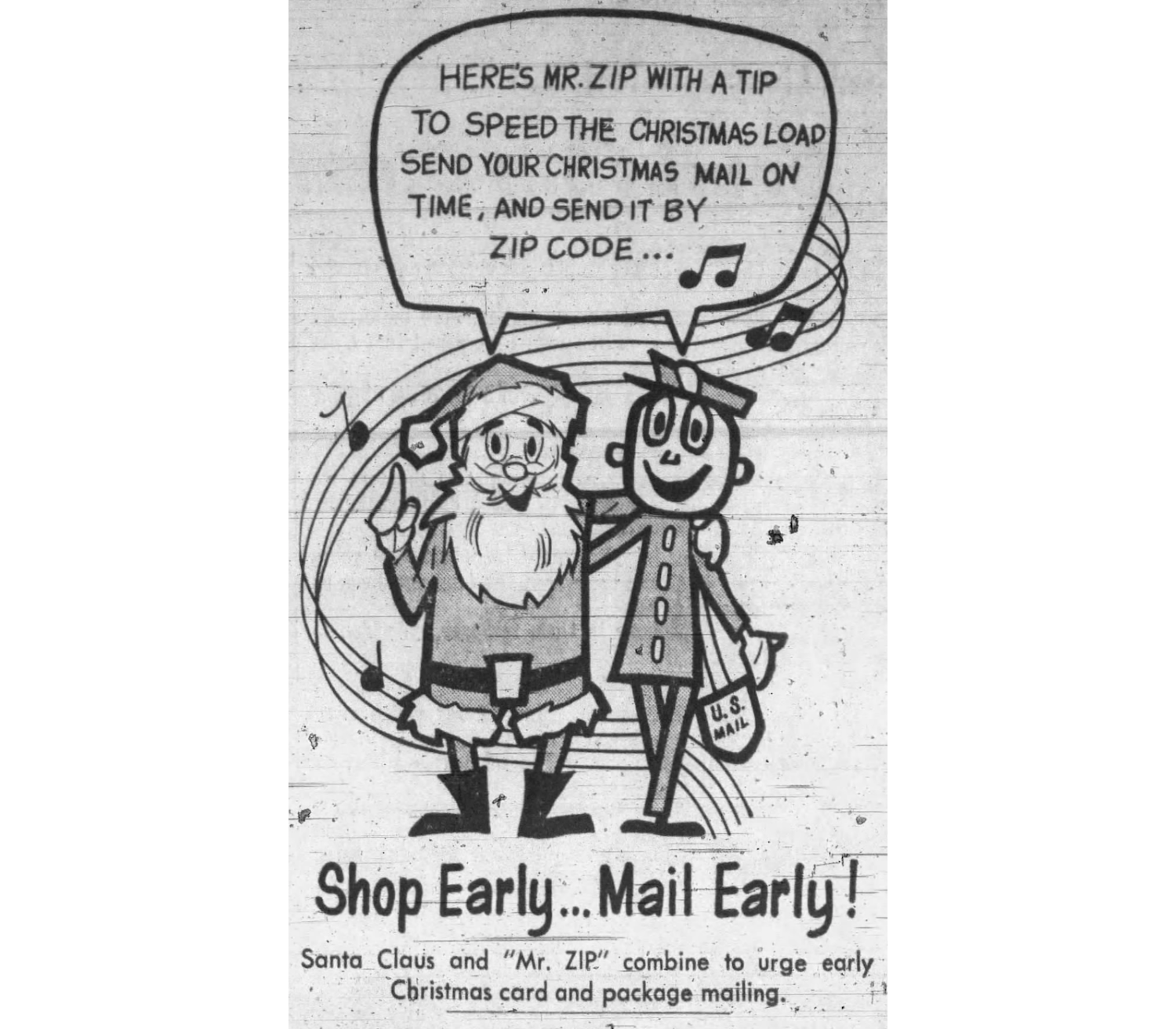 Deseret News (Salt Lake City, Utah), November 25th 1963
Deseret News (Salt Lake City, Utah), November 25th 1963
For many who were already frustrated at the Postal Service’s efforts at pushing ZIP codes on a number-weary populace, the use of Santa Claus as propaganda to brain-wash children into using ZIP codes was a reproachable act:
The United States Post Office Department has employed Santa Claus to intimidate children into using zip codes, the additional numerical designation of the area in which you live. It makes me so angry I could picket...As you know, there are still youngsters in America who, too young to steal cars and too innocent to marry, write to Santa. Also, there is a Post Office Department in America which, to further subdue man with digits, is anxious to have everyone use a zip code on letters.
Oakland Tribune, December 15th 1963
But for all of the initial resistance to ZIP codes, Mr. ZIP was an effective messenger. Within five years, he had achieved an 80% recognition with the general public, a feat for which almost any commercial brand would be envious, and led some to later claim that his saga was “one of the most successful trademark identification campaigns in the history of American advertising”. Within ten years of his introduction, Mr. ZIP had helped the US Postal Service achieve an almost 100 percent compliance in ZIP code usage, ushering in a trend that continues to this day.
A Shape-Shifter and His Codes
I would be remiss if I didn’t at least mention there was a dark side to this story. By the time Mr ZIP and his ZIP codes were introduced in 1963, 80 percent of all mail in the United States was business mail, not personal mail. Thus, the driving force behind the Postal Services use of ZIP codes was to improve the efficient handling of mail for businesses, not the average citizen. And yet, the messaging behind the ZIP code campaign was aimed at general public, encouraging everyone to do their part in helping out the national postal service or they might disappoint their postal workers, their community and even Santa himself.
And not unlike ZIP codes themselves, Mr ZIP’s origin story doesn’t begin as a public good, but rather as a product of big business. Originally devised by an advertising firm to help roll out a bank-by-mail initiative for the Chase Manhattan Bank of New York, Mr. Zip (unnamed at the time) appeared in posters alongside the co-opted postal phrase “In rain or hail, bank by mail”. But he was little used at the time and his design soon shelved.
His story doesn’t end there as he would eventually be resurrected by none other than AT&T, another client of the same advertising firm. AT&T would eventually acquire and then give the Mr. ZIP character to the Postal Service. And as the biggest business provider of organized communication at the time, they would continue to be heavily involved in the Postal Service’s propaganda campaign, putting up images of Mr. ZIP in their own offices and service trucks, as well as printing ZIP Code maps in the local yellow pages.
The story of Mr ZIP began on an airplane where then Postmaster General J Edward Day chanced to sit beside Frederick Kappel, then chairman of the board of American Telephone and Telegraph Company. During the course of conversation, Day mentioned that the Post Office Department was preparing to launch a new address zoning program. Kappel cautioned Day that unless properly handled, such a course could create public furor. He cited problems AT&T had encountered when it introduced all-digital dialing and area codes. AT&T officials later showed James F. Kelleher, Day's special assistant for public information, a cartoon character they had named "Mr P.O. Zone" and offered it to the post office as an item that could be used in promoting the new five-digit code. At a later meeting, the name ZIP Code was adopted - ZIP meaning Zone Improvement Plan.
Journal and Carrier (Lafayette, Indiana), July 2nd 1983
And thus Mr. ZIP was born. A one-time banking product peddler turned friendly but demanding messenger for a vast system of cryptic codes, a standard bearer for big business masquerading as a public good.
A Stand Against Elegant Simplicity
On the 50th anniversary of the ZIP Code, the US Postal Service’s Office of Inspector General (OIG) published “The Untold Story of the ZIP Code”, a report focused on telling story of the ZIP Code’s social and economic impact.
The report estimates that the ZIP Code adds an estimated $10 billion annually to various sectors of the economy, the majority of which is outside of the US Postal Service. Beyond its economic value, the report goes on to note that “the ZIP Code became a social tool for organizing and displaying demographic information, a support structure for entire industries such as insurance and real estate, and even a representation of social identities as observed in the television series Beverly Hills, 90210”.
But ZIP Codes have always been driven by the benefit they provide to businesses, not the public. From their beginning, it was the average citizen who was heavily encouraged to use ZIP codes to improve mail sorting efficiency in order to keep postage costs down, but it was the volume of bulk mailers across various industries that were driving up such costs. And yet the continued use of ZIP codes is a mental and infrastructural tax we must all pay to this day.
Even back in 1966, only three years after ZIP codes were first introduced, their industry impact outside the realm of mail sorting (outside the US Postal Service even) was being noticed by the postmaster of Provo, Utah, who helpfully highlighted ten novel applications of the new ZIP codes.
1. A number of firms are using ZIP Codes to establish and define territories for salesmen and/or agents as well as retail delivery routes.
2. An automotive parts company establishes parts inventories by ZIP Code area.
3. Two savings and loan associations use ZIP Code areas for advertising purposes and also to determine the number and amounts of savings and accounts.
4. The Council of California advises growers of planting methods, new developments, etc, in the agricultural field by ZIP Code area.
5. Several large department stores and many banks are conducting surveys of customer accounts by ZIP Code area prior to establishing branches.
6. Several firms are using ZIP Codes for market research and other analysis.
7. Two Internal Revenue offices have rearranged agent territory assignments to conform to ZIP Code Boundaries.
8. The City Water Works at Cedar Rapids, Iowa assigns meter readers by ZIP Code area.
9. Several firms use ZIP Code areas to determine results of fund solicitations, advertising, prospect areas and to define different types of markets.
10. An Insurance Company is assigned accident reports to claims adjustors by ZIP Code area.The Daily Herald (Provo, Utah), May 4th 1966
Taken in hindsight however, many of these applications we now know are actually harmful to many communities, enforcing negative biases and perpetuating damaging myths. And while the OIG report notes that “the ZIP Code possessed an elegant simplicity for efficiently organizing data by geography”, it’s often these exact types of simplicities that can cause the most lasting harm when businesses choose to rely on codified structures while ignoring the people behind the codes.
In some ways, the initial skepticism about ZIP codes, expressed by many at the time of their introduction, was well warranted. Their fears about living in a society run by numbers has been reawakened in modern times, as we all come to grips with how the numbers and codes we previously took for granted are actually hurting us in ways often unrealized and subtle.
The US Postal Service OIG’s report goes on to neutrally assert that “a ZIP Code and physical mailing address are widely recognized attributes of an individual’s identity” which “create a framework for social interaction and institutional coordination.” As we’re starting to feel the repercussions of our increasingly technology-driven social interactions and the “institution coordination” that provides a foundation for some of the worst aspects of our society, we must then ask the question: were ZIP Codes worth it?
It’s a question we’ve maybe forgotten to ask ever since they were first introduced. However New York actress Lee Grant offered a prescient warning back in 1963 when asked how she felt about the new ZIP Codes, replying:
I'm not sure I know what you're talking about but if this is another one of those campaigns to turn me into a number, I won't stand for it.
Nevada State Journal, April 14th 1964
- Posted on:
- January 23, 2020
- Length:
- 16 minute read, 3266 words
- See Also: